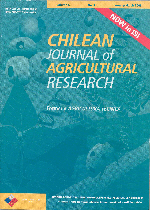
|
Agricultura Técnica
Instituto de Investigaciones Agropecuarias, INIA
ISSN: 0365-2807
EISSN: 0365-2807
Vol. 65, No. 1, 2005, pp. 65-73
|
 Bioline Code: at05007
Bioline Code: at05007
Full paper language: Spanish
Document type: Research Article
Document available free of charge
|
|
|
Agricultura Técnica, Vol. 65, No. 1, 2005, pp. 65-73
| es |
Redes neuronales para modelar predicción de heladas
Ovando, Gustavo; Bocco, Mónica & Sayago, Silvina
Resumen
En este trabajo se desarrollaron modelos basados en redes neuronales del tipo "backpropagation", para predecir la ocurrencia de heladas, a partir de datos meteorológicos de temperatura, humedad relativa, nubosidad, dirección y velocidad del viento. El entrenamiento y la validación de las redes se realizaron utilizando 24 años de datos meteorológicos correspondientes a la estación de Río Cuarto, Córdoba, Argentina, separados en 10 años como conjunto de datos de entrenamiento y 14 como conjunto de datos de validación. Se construyeron diferentes modelos para evaluar el comportamiento de las redes cuando se usan distintos números de variables de entrada y/o neuronas en la capa oculta y las probabilidades de aciertos en los resultados de predicción para los mismos, al considerar distintas variables de entrada. En los modelos realizados, el porcentaje de días con error de pronóstico fue de 2%, aproximadamente, para 14 años de aplicación; cuando se consideran días de heladas efectivas no pronosticadas los porcentajes oscilan entre un 10% y un 23%, para el mismo período. Los resultados de la simulación muestran el buen desempeño y la pertinencia general de esta metodología en la estimación de fenómenos de comportamiento no lineal como las heladas.
Palabras-clave
redes neuronales, predicción de heladas, modelos, backpropagation
|
| |
| en |
Neural networks for modeling frost prediction
Ovando, Gustavo; Bocco, Mónica & Sayago, Silvina
Abstract
In this work models based on neural networks of the backpropagation type were developed in order to predict the occurrence of frosts from meteorological data such as temperature, relative humidity, cloudiness and wind direction and speed. The training and the validation of the networks were made on the basis of 24 years of meteorological data corresponding to the Río Cuarto station, Córdoba, Argentina. These data were grouped as follows: 10 years for the training data set and 14 years for the validation data set. Different models were built to evaluate the performance of the networks when different numbers of input variables and/or neurons in the hidden layer are used, and the probabilities of success in the prediction results on considering different input variables. In the models used, the percentage of days with prediction error was 2%, approximately, for the 14 years of application; when effective frosts days are considered the percentage varies between 10 and 23%, for the same period. The simulation results demonstrated the good performance and the relevance of this methodology for the estimation of the behavior of non-linear phenomena like frosts.
Keywords
neural networks, frost prediction, models, backpropagation
|
| |
© Copyright 2005 - Instituto de Investigaciones Agropecuarias, INIA (Chile).
Alternative site location: http://www.inia.cl/at/agritec.htm
|
|
